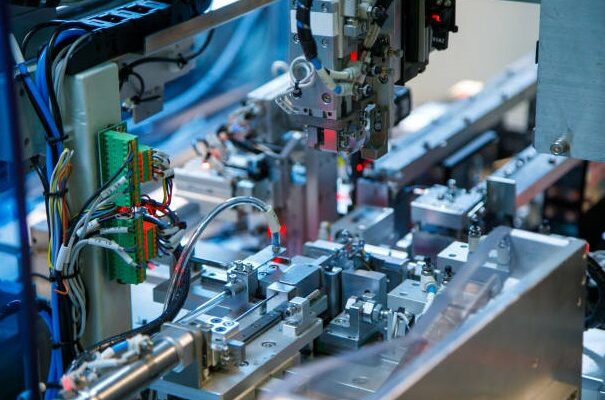Electronic machinery has become a cornerstone of modern life, playing a vital role across various sectors, including manufacturing, healthcare, communication, transportation, and home automation. From sophisticated industrial robots to simple household appliances, electronic machines enhance efficiency, precision, and convenience. This article explores the concept of electronic machinery, its components, types, applications, and the future of this transformative technology.
What is Electronic Machinery?
Electronic machinery refers to devices or systems that operate through electrical energy and electronic components to perform specific tasks. These machines integrate mechanical systems with electronic controls, making them highly efficient and intelligent. Unlike purely mechanical devices, electronic machinery can be automated, programmed, and controlled remotely, offering greater functionality.
Key Components of Electronic Machinery
Electronic machinery has several interconnected parts that perform complex functions. Some of the main components include:
1. Power Supply
Every electronic machine requires a stable power source, usually in the form of electricity. Power supply units convert and regulate the voltage necessary for operation.
2. Control Systems
Control units like microcontrollers, programmable logic controllers (PLCs), and embedded systems help manage the machine’s operations, often using pre-programmed logic.
3. Sensors and Actuators
Sensors collect data from the environment (e.g., temperature, motion, pressure) and feed it to the control unit. Actuators then execute actions based on control signals (e.g., moving an arm, turning a motor).
4. User Interface
Most electronic machines include a human-machine interface (HMI) such as touchscreens, buttons, or remote controls to allow user interaction.
Types of Electronic Machinery
Electronic gear falls under these categories:
1. Industrial Machinery
CNC machines, robotic arms, conveyor systems, and automated assembly lines are manufacturing tools.
2. Consumer Electronics
These are everyday devices used in homes and offices, such as washing machines, air conditioners, microwave ovens, and smart TVs.
3. Medical Equipment
Advanced electronic machines in healthcare include MRI scanners, ECG monitors, and robotic surgery systems that enhance diagnostic and therapeutic treatment precision.
4. Communication Devices
Mobile phones, routers, satellite systems, and broadcasting equipment fall under this category, enabling global communication.
5. Transportation Systems
Modern vehicles rely heavily on electronic machinery for engine control, GPS navigation, automatic braking systems, and electric propulsion.
Applications of Electronic Machinery
The influence of electronic machinery is widespread and multifaceted. Some of its most significant applications are:
Manufacturing Automation
Automation has revolutionized manufacturing, allowing for faster production, reduced labor costs, and improved quality control. Continuously operating machines require little human involvement.
Healthcare Advancements
In medical science, electronic machinery has facilitated early diagnosis, robotic surgeries, and efficient patient monitoring. Wearables also track health parameters live.
Smart Homes and IoT
Smart electronic devices in homes allow users to control lighting, temperature, and security systems through mobile applications, offering convenience and energy efficiency.
Education and Research
Laboratories and educational institutions use electronic machinery for experiments, simulations, and training purposes, enhancing learning outcomes and innovation.
Advantages of Electronic Machinery
The growing reliance on electronic machinery is due to the numerous benefits it offers:
- Increased Efficiency: Electronic machines perform tasks faster and with more precision than humans or traditional mechanical systems.
- Cost Savings: Automation leads to lower operational costs and minimal error-related losses.
- Improved Safety: Machines can do dangerous or repetitive activities, lowering worker injuries.
- Scalability: Machinery may be modified or reprogrammed for different duties, making it useful for changing industries.
Challenges and Limitations
Despite the advantages, electronic machinery also faces certain challenges:
- High Initial Investment: The cost of purchasing and setting up electronic machinery can be significant.
- Maintenance Requirements: Regular servicing and updates are essential to prevent breakdowns and ensure longevity.
- Job Displacement: Automation may lead to reduced demand for manual labor, posing economic challenges in certain sectors.
- Cybersecurity Risks: Connected machines, especially in industrial and smart home environments, are vulnerable to hacking and data breaches.
The Future of Electronic Machinery
As technology continues to evolve, electronic machinery is becoming more intelligent and autonomous. Innovations like artificial intelligence (AI), machine learning, and 5G connectivity are enabling machines to make real-time decisions and communicate seamlessly. Future trends may include:
- Self-healing machines that diagnose and repair their faults
- Green electronics with reduced energy consumption
- Cobots that work securely with humans
- Integration with quantum computing for complex problem-solving tasks
Conclusion
Electronic machinery powers the digital age. From small domestic devices to large industrial systems, these technologies have changed our lives and work. As we advance toward a more connected and automated future, the role of electronic machinery will only become more central in shaping society, industry, and everyday life.
If you want morе еxciting contеnt, visit. Globallyviz.com














Comments